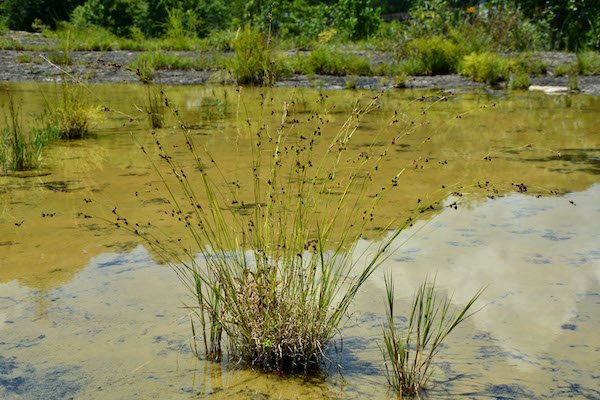The Stiletto Beaksedge
CLARKSVILLE, Tenn. – A new species of beaksedge, a grass-like plant found in wet areas, was recently described by Austin Peay State University alumna Claire M. Ciafré and her co-author Robert F. C. Naczi. This new beaksedge has been found only in seven locations in the entire world – all of which are in the southeastern U.S.
Ciafré first collected the new species in early 2019 while studying riverscour plant communities for her master’s thesis and work as a graduate research assistant with the Southeastern Grasslands Initiative and Center of Excellence for Field Biology at Austin Peay.
“I suspected I had something weird pretty quickly, but I only had one specimen at the beginning,” Ciafré said.
“I didn’t know if I had found something new, an existing species that hadn’t yet been found in North America, a hybrid or just a wonky individual – it’s amazing what fungal infections, insect galls, or stress can do to plants sometimes. But I think that uncertainty made everything even more exciting.”
When Ciafré’s efforts to identify the beaksedge continued to suggest an unknown species, she began contacting other botanists.
“Back then I was still pretty new to identifying beaksedges, so I wanted to be sure that I wasn’t missing something obvious or incorrectly interpreting a characteristic,” Ciafré said.
One of the botanists she reached out to was Robert Naczi, a beaksedge expert at the New York Botanical Garden. Naczi examined multiple pictures of Ciafré’s specimen and agreed that she might have found a previously undescribed species.
In the meantime, Ciafré did an exhaustive search of the Austin Peay herbarium looking for additional specimens that matched her unknown specimen. She found several specimens in the herbarium that matched hers but were identified as other species.
By that point, Naczi had found a specimen of the same entity that had been collected in Alabama, and suspected it was an undescribed species. After some excited emails, the two decided to collaborate on their study of the new beaksedge.
Their work showed that previous observations and collections of the species had been misidentified as a handful of other beaksedge species. To confirm that this was indeed a new species, they scoured plant specimens at 29 herbaria and studied it in the wild. Their description of Stiletto Beaksedge (Rhynchospora stiletto) as a new species was published in Kew Bulletin on Aug. 16, 2022.
Stiletto Beaksedge meets the IUCN classification standards for a vulnerable species. It only occurs in sunny, wet (or seasonally wet), calcium-rich but otherwise nutrient-poor grassland habitats. The seven sites where it has been documented are spread across Alabama, Arkansas, Missouri and Tennessee.
“It’s truly exciting to find something new in a region that is well-studied, particularly because it calls attention not only to a species of conservation concern but also to its imperiled habitat,” Ciafré said. “Over 99.9% of grasslands have been destroyed in the southeastern United States. Hopefully the recognition of Stiletto Beaksedge will bring more attention and conservation to the rich biodiversity southeastern grasslands still have to offer!”
Read the full species description at https://doi.org/10.1007/s12225-022-10044-1.

